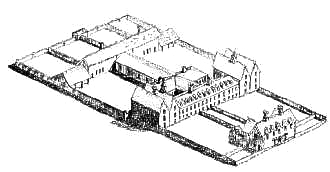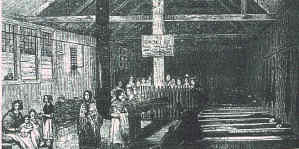
Bird's eye view of a workhouse
Workhouses were stark, bare, forbidding places meant to discourage people from entering. Each workhouse provided an apartment in the main building for the master and another nearby for the matron - sometimes the master and matron were married to each other. The master supervised the workhouse, subject to the Board of Guardians composed of local ratepayers. The Board also employed a clerk, teachers, nurses and other attendants.

Bird's eye view of a workhouse
People who entered the workhouse were destitute, starving, injured, sick or old and infirm. They needed permission first from a relieving officer and there was a strict rule that the whole family, including the father, had to enter together. This was meant to discourage men from leaving their families while they themselves travelled or emigrated to seek work. It could not be enforced in all cases as some men abandoned their families and women conspired with husbands to enter with their children for a while, pretending to be deserted, thus allowing the husband to migrate and seek employment.
The Poor Law Act (1838) placed the sole responsibility for supporting children born outside marriage on the mother and put the father under no legal obligation to his extra-marital child. Many single mothers had no option but to take refuge in workhouses. Rate-payers who funded the workhouses resented supporting these women and children and an Irish Poor Law Amendment Act was passed in 1862.
| It empowered boards of guardians to recover from a putative father the cost of maintaining his illegitimate child on the poor rates, after the mother had made a sworn statement, supported by corroborative evidence, before petty sessions ... The new laws gave no power to the mother to sue the father, and once she left the workhouse the liability of the father ended. Joseph Robins, The lost children: a study of charity children in Ireland 1700-1900, Dublin, 1980, p. 274. |
Most people arrived in rags and were given workhouse garb after being washed and disinfected. Then they proceeded to the main building where the family was broken up as women, men, girls and boys were sent to separate quarters, though infants were left with their mothers. The accommodation consisted of day rooms, yards, large dormitories and separate schoolrooms for boys and girls. The buildings and surroundings were bare and could be unpleasant and unhealthy, especially when overcrowded during the famine. Discipline could be very strict but, as in all organisations, varied from one institution to another.
Women were put to work washing, sewing, mending, cleaning, minding children.
| In the Ennistymon Union in 1857 the female paupers were engaged in the manufacturing of outfits for 400 inmates ... [Elsewhere] dresses, petticoats, shirts and chemises had to be made for each individual ... the repair and upkeep of inmates' clothes ... the repair of the houses' mattresses ... lace-making, embroidery, crochet, the knitting of stockings and the flowering of muslin. Dympna McLoughlin, 'Emigration of Irish pauper women' in Patk. O'Sullivan (ed.), Irish women and Irish migration, London, 1995, p.75. |
Overcrowding, especially in sleeping accommodation, caused rapid spread of disease.
| The medical officer [of the Dublin Union] attested in 1854 that the Workhouse was in an excessively overcrowded state. There were 292 two-tier beds and 438 three-tier beds. The diseased and dying in the infirmary lay two to a bed, no doubt accelerating the death rate. Dympna McLoughlin, 'Emigration of Irish pauper women' in Patk. O'Sullivan (ed.), Irish women and Irish migration, London, 1995, p.73. |

Women's dormitory in an English workhouse
As yet, no picture of Irish women in a workhouse
has been located.
The diseases of famine included typhus, yellow fever, dysentery, typhoid and scurvy, while cholera took many lives also. Some of these diseases are still found today in twentieth century famines.
Most people entered the workhouses only when they were destitute, when all sources of food failed or when they were very ill. Eliza Connor may have been a genuine case or perhaps 'working the system' when she entered Enniscorthy Workhouse ten times in 6½ years for periods ranging from four days in 1852 to ten months in 1855. She was admitted eight months pregnant in 1853 and her child was born during a three month stay in the workhouse.
The mortality rate of foundling children placed in workhouses was very high.
| The modern idea of childhood also gets in the way of understanding why the minding of foundling children was the least desirable of all occupations. Women outside the workhouse had to be paid an attractive wage to act as wet nurses. Pauper women within the workhouse had to be cajoled with a daily jug of porter to undertake the task, a task which was lower in prestige than washing the dead or cleaning the workhouse toilets. Dympna McLoughlin, 'Workhouses & Irish female paupers 1840-70' in Maria Luddy & Cliona Murphy (eds.), Women surviving, Dublin, 1989, p.142. |
Some children were abused and even lost without trace. Sixteen schoolgirls complained the Master of Tralee Union in 1844 of 'most improper conduct' and boys were abused by a wardsman in Dublin in 1863. Margaret Cleary went home sick from Birr workhouse, leaving her four children behind after the family had been admitted with fever. Two of her sons died in the workhouse and another disappeared never to be traced. An inquiry discovered that the master had recently taken a female pauper with him on a seaside holiday and had made a false entry about the missing boy in the register so he was asked to resign. At the same time, the nurse was dismissed for stealing a loaf of bread and the fat that rose to the surface of the workhouse soup.
Numbers of able-bodied male and female inmates in workhouses in the 19th century
| Year | Able-bodied males |
Able-bodied females |
Able-bodied males as % of the whole |
Able-bodied females as % of the whole |
|---|---|---|---|---|
| 1851 | 22,178 | 49,758 | 10.7 | 24.1 |
| 1861 | 2,623 | 7,799 | 5.5 | 16.5 |
| 1871 | 2,503 | 5,570 | 4.9 | 11.1 |
| 1881 | 3,308 | 5,515 | 6.0 | 10.0 |
| 1891 | 2,443 | 3,765 | 5.7 | 8.9 |
From Caitríona Clear, Nuns in nineteenth-century Ireland, Dublin, 1987, p.6.
The above figures show 'surplus able-bodied women' in the workhouses during the nineteenth century. Many had been reared in the workhouses without family ties or affection. Many were institutionalised, frustrated beyond imagining and difficult to manage.
Mary Keely, described as single and a servant, was admitted to the South Dublin Union fourteen times between 1855 when she was fifteen years old and 1858. During that time she served four spells in prison before she was,
| sentenced to four years' penal servitude for setting fire to her bed and breaking forty-two panes of glass. Maria Luddy, Women in Ireland: a documentary history, Cork, 1995, p.65. |
Prospects for 'surplus women' in workhouses were dismal and the Poor Law authorities feared many would leave, return when pregnant, bear several children and together with these children become a long-term burden on the ratepayers. Solutions included an Orphan Girl Emigration Scheme to Australia (1848-1850) which involved 4,175 girls. In addition over 50,000 women were given assistance to emigrate from Irish workhouses to North America between the years 1840 and 1870.